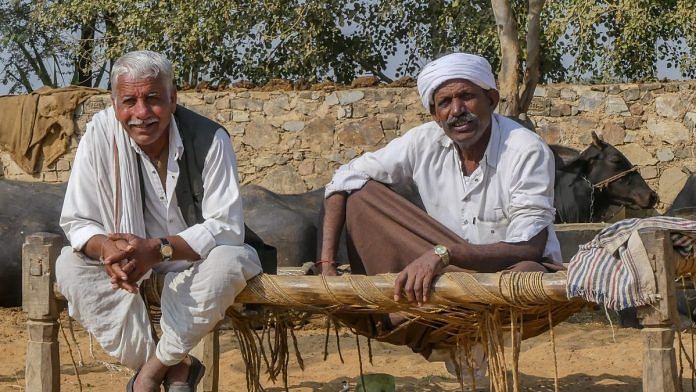Thank you dear subscribers, we are overwhelmed with your response.
Your Turn is a unique section from ThePrint featuring points of view from its subscribers. If you are a subscriber, have a point of view, please send it to us. If not, do subscribe here: https://theprint.in/subscribe/
Agar- Bhanwta -two of the remotest villages of Rajasthan with undulating Aravallis, crisp air, clear blue sky, close-knit communities, strong social bonds and man- animal supportive environment were established in 1572 in the then Rajputana.
For over 400 years the Elders were the role models for the Young and custodians of local traditions, values, beliefs, customs & knowledge. They played a vital role in decision making, conflict resolution and community development.
The women were colorfully dressed and multitaskers.
They worked in the fields, fed and cared for their goats. They looked after and cooked for the family. They spent hours weaving carpets of natural materials like wool, silk and cotton on wooden hand- stuffing looms installed in the covered part of the courtyards. Periodically they also maintained their traditional houses of mud, straw and stones .
The men of Agar- Bhanwta wore dhoti, kurta, safa and juties. They practiced dowsing with the help of their forked sticks . Dowsing was a sensory cue to guess potential underground water sources. To capture rain water they made small and medium sized dams of clay and stones. To store rain and run off water they made ponds and tankas.
Each pond was about 10x10x3 feet depression. Each tankas was about 20x14x8 feet cylindrical pit. Both were lined with of mud, stones and lime. Water from the villages flowed into The tanka had catchment area 20 square meters to 2 hectares in size.
In addition men were efficient goatherds, folk singers, creators of tie and dye patterns, performers of Maand and Pabuji ki Phad, narrators of stories of real life heros, makers of miniature paintings, inlayers of different materials into marble surfaces and puppeteers creating narratives,conveying emotions and entertaining.
Then Agar-Bhanwta changed. Free mobile phones invaded , intruded lives. Farmers started using chemical pesticides leading to agricultural pollution,soil erosion , decreased agricultural output and poor health of the residents and livestock.
Mobile phones became casinos. Many users started gambling, got addicted to it and suffered financial losses, anxiety and isolation.
The area got littered with plastic carry bags, empty bottles, mulch films and packagings. Plastic pollution impacted the health of humans and livestock.
It all led to weakening and erosion of individual core values and collapse of a generation. The young spent time on online games and/or watching mindless serials.
Many got allured to easy money and for that started making their own funny videos and posting them on U Tube. Quite a few became models for ‘strip chat’ – an international live webcam website and became part of the porn industry.
The wise elders realised their young were retrogressing. Compassionate and mindful young were becoming indifferent. Instead of minimalism and reusing every thing they were becoming impulsive consumerists. They initiated ‘Prosperity with Dignity’ drive.
Work started with the help of behavioral scientists, educationists, technology experts, water experts, agriculturists, infrastructure developers, animal welfare professionals, upcycling experts and rural tourism practitioners.
80 young between the age of 18 to 25 were selected by behavioral scientists. Educationists shaped them.
Experts
- Set a library and, an informal school.
- Started hand made paper recycling unit.
- Started earthen block making unit.
- Started composting unit.
- Guided in making low cost tablets.
- Guided in making low cost smart phones.
Water experts
- trained them in constructing small & medium sized dams of stone and clay
- trained them in repairing leaking pipes
- Trained them in repairing handpumps
- Trained them in constructing ponds
- Trained them in constructing tankas.
Agriculturists
- trained them in better farming practices.
- Trained them in growing year round low water crops.
- Trained them in planting trees like palash, amla, dhok,khejri,khajoor and papaya on fences of their fields.
- Trained them in converting arid land to fertile land.
Infrastructure developers
- assessed the existing infrastructure
- Trained to plan and construct roads, streets, drains and power station
- Trained in setting transportation hubs
- Trained in making low cost innovative vehicles.
Animal welfare professionals
- helped upkeep of the health of livestock.
- Helped in setting go-shala
- Helped in starting a barn for street cattle.
- Helped in starting a hostel for stray dogs.
Upcyclers
- helped create costume jewellery of used beads, glass,stones;
- Trained potters to make terracotta water bottles.
- Helped set up a unit to make baggase plates.
- Helped set up a unit to make cast iron cookware.
- Helped set a unit to make bamboo straws, raizors & tooth brushes.
- Helped start a unit to make natural pesticides.
- Helped start a unit to make pickles & murabba.
- Helped start a unit to make products from palash, kejri,desi babul and khajoor trees.
- Helped start a unit to make stone ware & sculptures
- Helped start a unit to make water purifiers with jowar husk and mehndi powder to combat excessive fluoride in the water.
Rural tourism experts
- focused on developing and promoting tourism by highlighting local culture, heritage, and natural attractions,
- Telling Agar- Bhanwta’s success story based on its initiatives like cleanliness drives,composting, setting solar unit with solar panels, lights, fans, cookers; hand made paper, hand loom hub with reusable non plastic shopping bags, yoga mats, tie & dye garments, block print table ware and bed clothes.
Last words
Clean and green Agar- Bhanwta will have healthy economy and happy people. It would be is a role model for the villages suffering from agricultural pollution, rural- urban migration, mobile and substance addiction and generation collapse.
These pieces are being published as they have been received – they have not been edited/fact-checked by ThePrint.


